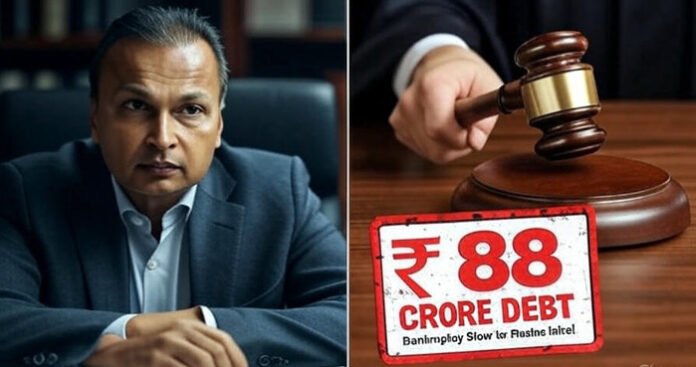
INVC NEWS
Mumbai — : The Reliance Infrastructure, led by industrialist Anil Ambani, is once again under financial scrutiny as the Mumbai Bench of the National Company Law Tribunal (NCLT) has admitted an insolvency petition against the company. The bankruptcy petition was filed by IDBI Trusteeship Services Ltd over alleged unpaid dues exceeding ₹88 crore. This ruling is viewed as a major shock to investors who had anticipated a positive turnaround in the company’s financial trajectory.
The tribunal has also appointed Tehseen Fatima Khatri as the Interim Resolution Professional (IRP), effectively starting the Corporate Insolvency Resolution Process (CIRP) against Reliance Infrastructure, despite the company’s claims of payment compliance.
IDBI Trusteeship’s Insolvency Petition Triggers Bankruptcy Proceedings
The roots of this dispute stretch back to a 2011 Energy Purchase Agreement (EPA) signed between Reliance Infrastructure and Dhursar Solar Power Private Limited (DSPPL). Under this EPA, Reliance Infra committed to purchasing all power generated by DSPPL’s solar facility.
In 2012, a tripartite direct agreement was signed involving IDBI Trusteeship, DSPPL, and Reliance Infra, which transferred DSPPL’s claims to IDBI Trusteeship. Between 2017 and 2018, DSPPL raised ten invoices for energy supplied. According to IDBI, Reliance Infra did not clear the dues, despite repeated demands, prompting them to invoke the Insolvency and Bankruptcy Code (IBC) in April 2022, claiming an overdue amount plus interest totaling over ₹88 crore.
Reliance Infrastructure’s Stand: “No Default Exists”
In its official statement, Reliance Infrastructure strongly opposed the NCLT ruling, claiming it had fully paid ₹92.68 crore to DSPPL in accordance with the EPA. The company emphasized that this sum covers all dues and that the NCLT’s order should be rendered inapplicable.
A company spokesperson stated, “The entire due amount was paid to Dhursar Solar Power Private Limited. The company will appeal to NCLAT to have the NCLT’s order dated 30 May 2025 annulled.” Furthermore, Reliance Infra argued that the insolvency plea was time-barred, pointing out that the last invoice was issued in September 2018, with the payment deadline in November 2018, making the April 2022 petition legally untenable.
Tribunal Rejects Stay Plea, IRP Process to Proceed
Despite Reliance Infra’s appeal for a stay on the CIRP and a block on the IRP taking over management, the tribunal stood firm. The bench ruled that once the admission order was issued, the process could not be paused.
The judgment could mark a turning point for Anil Ambani’s infrastructure empire, which had recently begun showing signs of recovery. Investors and market watchers are closely monitoring how the appellate tribunal NCLAT will respond in the coming weeks.
A Pivotal Moment: R Infra’s Financial Comeback Faces Roadblock
The latest development is especially jarring considering Reliance Infrastructure’s recent financial disclosures. The company had declared itself debt-free, having repaid over ₹3,298 crore in loans during FY2025. Additionally, it posted a consolidated profit of ₹4,387 crore, signaling a strong financial rebound.
Reliance Infra was being touted as a comeback story for Anil Ambani, whose corporate legacy had taken a hit in the past decade. Investors had reposed fresh faith in the stock as the company cleaned up its balance sheet and returned to profitability. The NCLT’s decision has now cast a shadow over this revival narrative.
DSPPL, EPA, and Dispute Timeline
The conflict originates from the 2011 EPA, which obligated Reliance Infra to purchase all energy generated by DSPPL. IDBI Trusteeship stepped in as the financial custodian through a direct tripartite agreement.
Despite invoices raised between 2017–2018, DSPPL and IDBI claim no payment was received. Notices were served under the IBC in 2022, seeking redress. While Reliance Infra insists on full settlement, the legal technicality of limitation period and contractual disputes have intensified the battle.
What’s at Stake for Reliance Infrastructure?
Admission of the insolvency petition triggers the initiation of CIRP, during which the company’s board is suspended, and management transfers to the Interim Resolution Professional. If unresolved, this may lead to the company being sold, restructured, or liquidated under IBC provisions.
Even though Reliance Infra maintains that the dues are cleared, the legal validation of this claim now rests with the National Company Law Appellate Tribunal (NCLAT). Should NCLAT overturn the order, the company might avoid deeper implications. If not, the valuation and operations of Reliance Infra could come under major pressure.
Investor Sentiment and Market Reactions
The equity market has responded with mixed sentiments. Some analysts view this as a technical legal hurdle, while others fear a deeper issue related to contractual compliance and debt resolution.
Reliance Infrastructure’s stock remains under high surveillance, as investors await developments from NCLAT. The ruling has underscored the volatile nature of unresolved commercial disputes in legacy contracts.
The outcome of this case will determine whether Reliance Infrastructure’s resurgence can withstand this legal blow. Market participants will be focused on the upcoming NCLAT hearing and whether the company can maintain operational continuity amid the initiation of the insolvency process.












